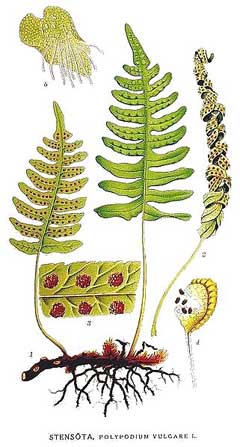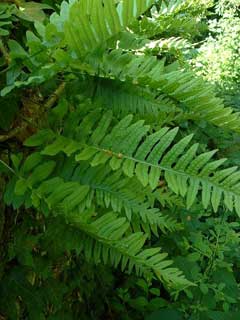 |
|
http://commons.wikimedia.org/wiki/File:499_Polypodium_vulgare.jpg |
 |
| http://fr.wikipedia.org/wiki/Utilisateur:Jeffdelonge |
Translate this page:
Summary
Form: Irregular or sprawling, Rounded, Upright or erect.
Physical Characteristics

 Polypodium_vulgare is an evergreen Fern growing to 0.3 m (1ft) by 0.3 m (1ft in) at a fast rate.
Polypodium_vulgare is an evergreen Fern growing to 0.3 m (1ft) by 0.3 m (1ft in) at a fast rate.
See above for USDA hardiness. It is hardy to UK zone 3. It is in leaf all year.
Suitable for: light (sandy), medium (loamy) and heavy (clay) soils, prefers well-drained soil and can grow in heavy clay and nutritionally poor soils. Suitable pH: mildly acid, neutral and basic (mildly alkaline) soils. It can grow in full shade (deep woodland) or semi-shade (light woodland). It prefers dry or moist soil.
UK Hardiness Map
US Hardiness Map
Synonyms
Plant Habitats
Edible Uses
Root. Very sweet, it contains sugars, tannin and oils[13]. It is used as a liquorice adulterant[7]. The root has a unique, rather unpleasant odour and a sweet (cloying) flavour at first though it quickly becomes nauseating[222]. The root contains 15.5% saccharose and 4.2% glucose[218].
References More on Edible Uses
Medicinal Uses
Plants For A Future can not take any responsibility for any adverse effects from the use of plants. Always seek advice from a professional before using a plant medicinally.
Polypody stimulates bile secretion and is a gentle laxative. In European herbal medicine it is traditionally used as a treatment for hepatitis and jaundice and as a remedy for indigestion and loss of appetite[254]. It should not be used externally since it can cause skin rashes[254]. The root is alterative, anthelmintic, cholagogue, demulcent, diuretic, expectorant, pectoral, purgative, tonic[4, 238, 240]. It can be used either fresh or dried and is best harvested in October or November, though it can be collected until February[4]. The leaves can also be used but are less active[4]. A tea made from the roots is used in the treatment of pleurisy, hives, sore throats and stomach aches and as a mild laxative for children[222]. It was also considered of value for lung ailments and liver diseases[222]. The poulticed root is applied to inflammations[222]. A tea or syrup of the whole plant is anthelmintic[222].
References More on Medicinal Uses
The Bookshop: Edible Plant Books
Our Latest books on Perennial Plants For Food Forests and Permaculture Gardens in paperback or digital formats.

Edible Tropical Plants
Food Forest Plants for Hotter Conditions: 250+ Plants For Tropical Food Forests & Permaculture Gardens.
More

Edible Temperate Plants
Plants for Your Food Forest: 500 Plants for Temperate Food Forests & Permaculture Gardens.
More

More Books
PFAF have eight books available in paperback and digital formats. Browse the shop for more information.
Shop Now
Other Uses
Plants can be grown as a ground cover in a shady position[188, 200]. They form a spreading carpet and are best spaced about 30cm apart each way[208]. The ash of burnt leaves is rich in carbonate of potash[4].
Special Uses
References More on Other Uses
Cultivation details
Landscape Uses:Border, Container, Erosion control, Foundation, Ground cover, Massing, Rock garden, Woodland garden. Easily grown in most light soils[187]. Prefers a soil of leaf mould and a cool but not too moist clay[1]. Prefers a cool damp shady position[1]. Thrives in dry shade[28, 188]. Established plants are drought tolerant[208]. They grow well on drystone walls[200]. Plants often grow as epiphytes[28, 31]. Members of this genus are rarely if ever troubled by browsing deer[233]. A rather variable plant, it is considered to be an aggregate species of several very similar species[187]. Only the roots should be planted, the rhizome being fixed to the surface of the soil[1, 187]. Special Features:
Attractive foliage, Not North American native, There are no flowers or blooms. Polypodium virginianum (Polypodium vulgare subsp. virginianum (L.) Hultén is a synonym of Polypodium virginianum L.) commonly know as rock cap fern, or common polypody tolerates hardiness zones down to 3. It prefers acidic soil. It is a small evergreen species of fern native to the Eastern United States and Canada. It generally grows on rocks and occasionally on tree roots in nature. A small rhizomatous fern with narrow leaves 8–40 centimetres (3.1–15.7 in) long and 3–6 centimetres (1.2–2.4 in) wide. Polypodium virginianum typically grows on boulders, cliffs, and rocky slopes and does not need well-developed soil. The plant is heat tolerant in zones 9 through 1. (Plant Hardiness Zones show how well plants withstand cold winter temperatures.
Plant Heat Zones show when plants would start suffering from the heat.
The Plant Heat Zone map is based on the number of "heat days" experienced in a given area where the temperature climbs to over 86 degrees F (30°C).
At this temperature, many plants begin to suffer physiological damage. Heat Zones range from 1 (no heat days) to 12 (210 or more heat days).
For example Heat Zone. 11-1 indicates that the plant is heat tolerant in zones 11 through 1.) For polyculture design as well as the above-ground architecture (form - tree, shrub etc. and size shown above) information on the habit and root pattern is also useful and given here if available. The plant growth habit is a clumper with limited spread [1-2]. The root pattern is rhizomatous with underground stems sending roots and shoots along their length [1-2].
References Carbon Farming Information and Carbon Sequestration Information
Temperature Converter
Type a value in the Celsius field to convert the value to Fahrenheit:
Fahrenheit:
The PFAF Bookshop
Plants For A Future have a number of books available in paperback and digital form. Book titles include Edible Plants, Edible Perennials, Edible Trees,Edible Shrubs, Woodland Gardening, and Temperate Food Forest Plants. Our new book is Food Forest Plants For Hotter Conditions (Tropical and Sub-Tropical).
Shop Now
Plant Propagation
Spores - best sown as soon as they are ripe, though they can also be sown in the spring. Sow them on the surface of a humus-rich sterilized soil. Keep the compost moist, preferably by putting a plastic bag over the pot. Pot on small clumps of plantlets as soon as they are large enough to handle and keep humid until they are well established. Do not plant outside until the ferns are at least 2 years old and then only in a very well sheltered position. Division. This is best done in the spring but it succeeds at most times of the year[1].
Other Names
If available other names are mentioned here
Native Range
TEMPERATE ASIA: Armenia, Azerbaijan, Ciscaucasia, Dagestan, Georgia, Hokkaidô, Honshu, Japan, Kazakhstan, Kyrgyzstan, Russian Federation, Russian Federation-Ciscaucasia, Russian Federation-Western Siberia, Turkey, Western Siberia,Iran. NORTHERN AMERICA: Greenland, EUROPE: Denmark, Finland, United Kingdom (U.K.), Ireland, Iceland, Norway, Austria, Belgium, Switzerland, Czech Republic, Germany, Hungary, Netherlands, Poland, Slovakia, Russian Federation-European part, European part, Lithuania, Latvia, Moldova, Russian Federation, Saratov, Ukraine (incl. Krym), Albania, Bulgaria, Bosnia and Herzegovina, Greece, Croatia, Italy, North Macedonia, Montenegro, Romania, Serbia, Slovenia, Spain, France, Portugal, AFRICA: Spain, Canarias, Portugal, Madeira Islands, Morocco, Tunisia, Lesotho, South Africa, Cape Province, KwaZulu-Natal, .
Weed Potential
Right plant wrong place. We are currently updating this section.
Please note that a plant may be invasive in one area but may not in your area so it’s worth checking.
Conservation Status
IUCN Red List of Threatened Plants Status :

Growth: S = slow M = medium F = fast. Soil: L = light (sandy) M = medium H = heavy (clay). pH: A = acid N = neutral B = basic (alkaline). Shade: F = full shade S = semi-shade N = no shade. Moisture: D = dry M = Moist We = wet Wa = water.
Expert comment
Author
L.
Botanical References
17200
Links / References
For a list of references used on this page please go here
Readers comment
| Add a comment |
|
If you have important information about this plant that may help other users please add a comment or link below. Only comments or links that are felt to be directly relevant to a plant will be included. If you think a comment/link or information contained on this page is inaccurate or misleading we would welcome your feedback at [email protected]. If you have questions about a plant please use the Forum on this website as we do not have the resources to answer questions ourselves.
* Please note: the comments by website users are not necessarily those held by PFAF and may give misleading or inaccurate information.
To leave a comment please Register or login here All comments need to be approved so will not appear immediately.
|
Subject : Polypodium_vulgare
|
|
|
|